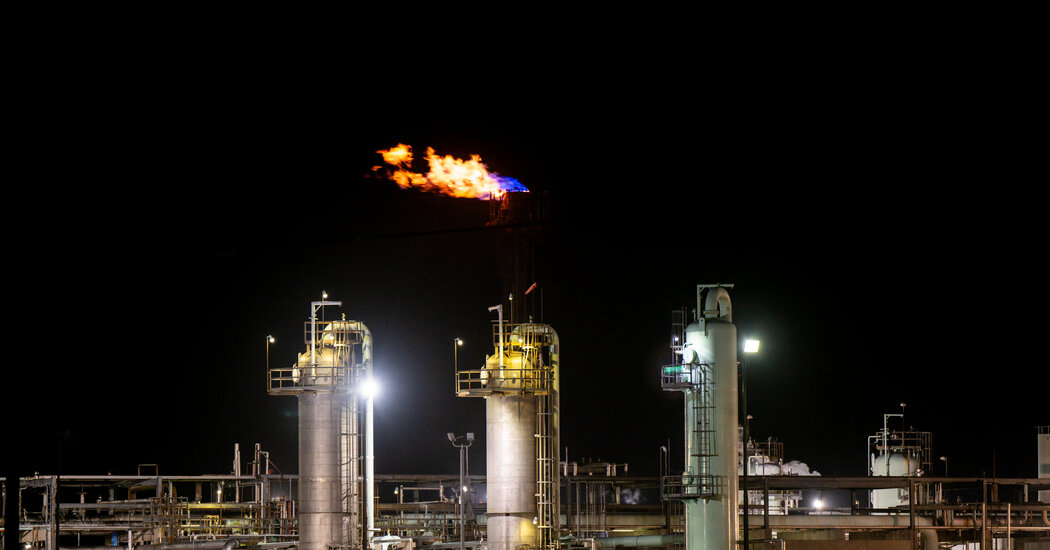

In 2030, if current projections hold, the United States will drill for more oil and gas than at any point in its history. Russia and Saudi Arabia plan to do the same.
They’re among the world’s fossil fuel giants that, together, are on course this decade to produce twice the amount of fossil fuels than a critical global warming threshold allows, according to a United Nations-backed report issued on Wednesday.
The report, which looked at 20 major fossil fuel producing countries, underscores the wide gap between world leaders’ lofty promises to take stronger action on climate change and their nations’ actual production plans.
This month, leaders are set to gather at a global climate summit in Dubai to discuss how to reduce their planet-warming emissions. But in the face of strong opposition from major fossil fuel producers, climate conferences have so far shied away from discussing a phaseout of fossil fuels.
Emissions from burning coal, oil and gas are the main drivers of global warming, which is already intensifying storms, flooding, heat waves, wildfires and droughts. Scientists say it is more likely than not that 2023 will be the hottest year on record.
“We cannot address climate catastrophe without tackling its root cause: fossil fuel dependence,” António Guterres, the United Nations secretary general, said.
“Fossil fuel emissions are already causing climate chaos which is devastating lives and livelihoods,” he said. Yet, “governments are literally doubling down on fossil fuel production.”
Nearly every country signed the Paris Agreement in 2015, the global climate pact that aims to limit the rise in average global temperatures to well below 2 degrees Celsius, and ideally no more than 1.5 degrees Celsius, or 2.7 degrees Fahrenheit, compared with preindustrial levels.
And over the past decade, governments and businesses have made progress in weaning themselves from fossil fuels by ramping up wind and solar power, for example, and investing in electric vehicle infrastructure.
Yet the report issued on Wednesday, led by researchers at the Stockholm Environment Institute, found that nations of the world plan to keep increasing coal production until 2030, and oil and gas production decades beyond that.
That means the world remains on track to produce around 110 percent more oil, gas and coal through 2030 as would be allowable if governments wanted to limit warming to 1.5 degrees Celsius, the researchers warned. The world was also set to overshoot, by 69 percent, the amount of fossil fuels consistent with limiting warming to 2 degrees Celsius.
Beyond those thresholds, the world faces the danger of irreversible and catastrophic damage from climate change, scientists say. The planet has already warmed an average of 1.2 degrees Celsius from preindustrial levels.
There have been some signs of progress. In September, the first official report card on the global climate pact said the absolute worst-case climate change scenarios that were feared in the early 2010s looked far less likely today. The authors partly credited nations’ nascent efforts to rein in their emissions under the 2015 Paris Agreement, and the rapid growth in clean energy.
Last month, the world’s leading energy agency predicted that the global demand for fossil fuels could in fact peak by 2030, as policies to promote cleaner forms of energy and transportation take hold.
That prediction was criticized by the oil-producing nations themselves, however: The oil cartel OPEC warned that such forecasts could lead countries to underinvest in oil and gas projects, leading to a lack of supply and “energy chaos.”
Wednesday’s report squarely lays the onus of curbing fossil fuel production on the world’s richest nations. For each fossil fuel — coal, oil or gas — the combined levels of production being planned by the 10 highest-income countries alone would already warm the world beyond 1.5 degrees by 2040, said Ploy Achakulwisut, who led the research.
State-owned companies control about half the world’s output of oil and gas, and more than half of coal. But even in countries like the United States, where the private sector is dominant, government policies like fossil fuel subsidies and tax breaks continue to prop up production. Global fossil-fuel subsidies jumped to a record $7 trillion last year, according to a tally by the International Monetary Fund. That is more than governments around the world spend annually on education.
Some nations that sit on sizable fossil fuel reserves are now vying to be the last producers standing even as the overall market starts to slow, saying they can drill for fossil fuels more cleanly than their competitors, the researchers said.
“But when you take all of these together, that’s what leads to the production gap,” Michael Lazarus, a co-author of the report, said. “It’s that desire for each country to maximize their own production.”
24World Media does not take any responsibility of the information you see on this page. The content this page contains is from independent third-party content provider. If you have any concerns regarding the content, please free to write us here: contact@24worldmedia.com

Common Mistakes When Using Athletic Field Tarps

High-Performance Diesel Truck Upgrades You Should Consider

Warehouse Optimization Tips To Improve Performance

Fire Hazards in Daily Life: The Most Common Ignition Sources

Yellowstone’s Wolves: A Debate Over Their Role in the Park’s Ecosystem

Earth Day 2024: A Look at 3 Places Adapting Quickly to Fight Climate Change

Millions of Girls in Africa Will Miss HPV Shots After Merck Production Problem

This Lava Tube in Saudi Arabia Has Been a Human Refuge for 7,000 Years

Four Wild Ways to Save the Koala (That Just Might Work)

National Academy Asks Court to Strip Sackler Name From Endowment

Ways Industrial Copper Helps Energy Production

The Ins and Out of Industrial Conveyor Belts